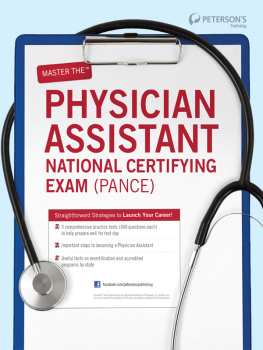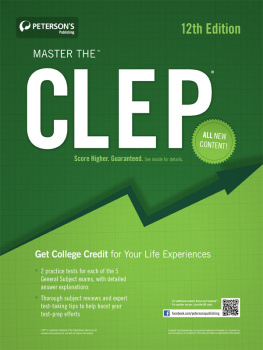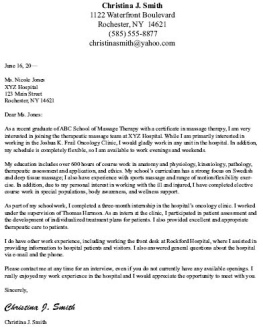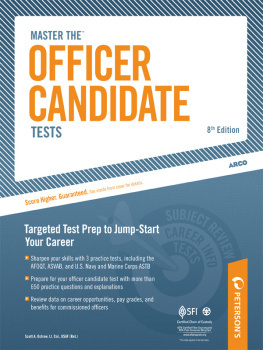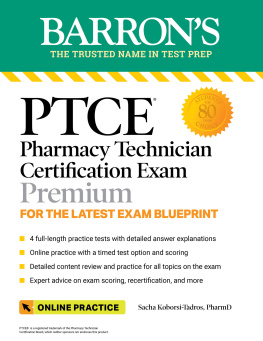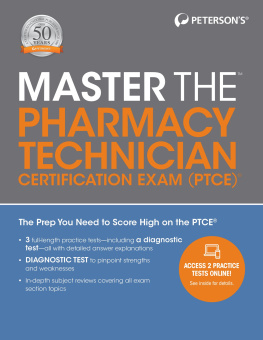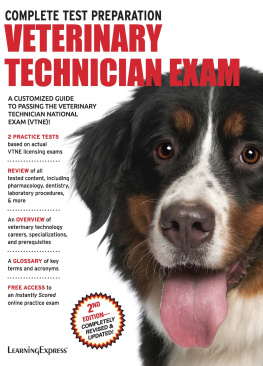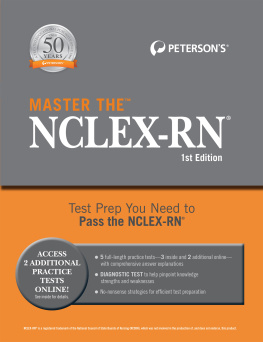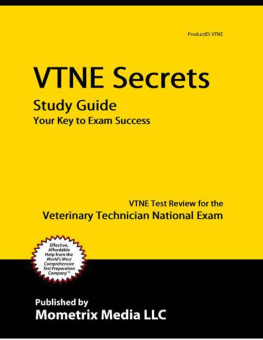Table of Contents
Master the
Veterinary Technician National Examination
(VTNE)
1st Edition

ABOUT PETERSONS PUBLISHING
To succeed on your lifelong educational journey, you will need accurate, dependable, and practical tools and resources. That is why Petersons is everywhere education happens. Because whenever and however you need education content delivered, you can rely on Petersons to provide the information, know-how, and guidance to help you reach your goals. Tools to match the right students with the right school. Its here. Personalized resources and expert guidance. Its here. Comprehensive and dependable education contentdelivered whenever and however you need it. Its all here.
For more information, contact Petersons Publishing, 2000 Lenox Drive, Lawrenceville, NJ 08648;
800-338-3282 Ext. 54229; or find us online at www.petersonspublishing.com.
2011 Petersons, a Nelnet company
Facebook and Facebook logos are registered trademarks of Facebook, Inc. Facebook, Inc. was not involved in the production of this book and makes no endorsement of this product.
Bernadette Webster, Director of Publishing; Jill C. Schwartz, Editor; Ray Golaszewski, Publishing Operations Manager; Linda M. Williams, Composition Manager
ALL RIGHTS RESERVED. No part of this work covered by the copyright herein may be reproduced or used in any form or by any meansgraphic, electronic, or mechanical, including photocopying, recording, taping, Web distribution, or information storage and retrieval systemswithout the prior written permission of the publisher.
For permission to use material from this text or product, complete the Permission Request Form at
http://www.petersons.com/permissions.
ISBN-13: 978-0-7689-3524-0
ISBN-10: 0-7689-3524-5
Before You Begin
OVERVIEW
- How this book is organized
- Special study features
- Youre well on your way to success
- Give us your feedback
- Todays opportunities for veterinary technicians
HOW THIS BOOK IS ORGANIZED
Veterinary technician is a good career choice for individuals who love animals and want to spend their days caring for them. Veterinary technicians also often enjoy job security, good pay, and great benefits. The U.S. Bureau of Statistics reports that over the next decade, employment for veterinary technicians is expected to grow much faster than average and overall job opportunities should be excellent.
Those interested in becoming a veterinary technician must complete a two-year associate degree program accredited by the American Veterinary Medical Association (AVMA) and then take and pass a national examination, the Veterinary Technician National Examination (VTNE), which is offered in most states.
The veterinary technician career has changed significantly in recent yearsfrom the job title itself to employment prospects. For more on this, take a look at Todays Opportunities for Veterinary Technicians, by Kimberly Myers, Associate Professor of Veterinary Technology at the University of Cincinnati, which appears at the end of this section.
This book was carefully researched and written to help you prepare for the VTNE. The chapters in this book explain what it is like to work as a veterinary technician and review important material that is likely to appear on the VTNE. Completing the many practice exercises and practice tests in this book will help you pass this exam.
To get the most out of this book, take the time to read each section carefully and thoroughly.
- Part I provides an overview of a veterinary technicians job responsibilities and the places where veterinary technicians work. It offers information about the education you need to become a veterinary technician and the subjects assessed on the Veterinary Technician National Examination (VTNE), the national exam given in most states. Part I also outlines the steps you need to take to become a veterinary technician, including preparing and applying for the VTNE and becoming registered, licensed, and/or certified.
- Part II is a preview of the written examination. This section introduces you to the kinds of questions you will see on the VTNE, including questions about pharmacy, pharmacology, surgical preparation and assisting, laboratory procedures, animal care and nursing, anesthesia and analgesia, and dentistry and diagnostic imaging.
- Part III is a comprehensive overview of the types of questions you will see on the VTNE. A chapter is devoted to each subject area, or domain, on the test. Each chapter begins with a review of the subject matter to refresh your memory as to what you learned in school. At the end of each chapter are practice exercises. The multiple-choice questions in the practice exercises are just like those on the actual test. Complete the questions and study the answer explanations. You can learn a great deal from these explanations. Even if you answered the questions correctly, you may discover a new tip in the explanation that will help you answer other questions.
- When you feel that you are well prepared, move on to Part IV the Practice Tests. These practice examinations contain new questions modeled after the samples provided in Information for Candidates on the Veterinary Technician National Examination , published by Professional Examination Services (PES), the company that administers the test, which is sponsored by the American Association of Veterinary State Boards (AAVSB). The questions on the Practice Tests in this book are not the actual questions that you will see on the exam. If possible, try to work through an entire exam in one sitting. On the actual test, you will have 4 hours to complete the exam, so allow yourself this amount of time. If you must divide your time, divide it into no more than two sessions per exam. Do not look at the correct answers until you have completed the exam. Remember, these tests are for practice, and they will not be scored. Take the time to learn from any mistakes you may make.
- The Appendixes offer a list of medical terms and abbreviations used on the VTNE and a list of references recommended by the American Veterinary Medical Association (AVMA). Study the abbreviations until you are sure that you know them. Consult the references if you need additional veterinary information or if you have a professional question or concern.
SPECIAL STUDY FEATURES
Master the Veterinary Technician National Examination (VTNE) is designed to be as user friendly as it is complete. To this end, it includes several features to make your preparation more efficient.
Overview
Each chapter begins with a bulleted overview listing the topics covered in the chapter. This allows you to target the areas in which you are most interested.
Summing It Up
Each chapter ends with a point-by-point summary that reviews the most important items in the chapter. The summaries offer a convenient way to review key points.
Notes
Notes highlight need-to-know information about the Veterinary Technician National Exam (VTNE), whether it is details about scoring or the structure of the question type.
Tips
Tips provide valuable strategies and insider information to help you score your best on the Veterinary Technician National Exam (VTNE).
SPECIAL ADVERTISING SECTION
At end of the book, dont miss the special section of ads placed by Petersons preferred clients. Their financial support helps make it possible for Petersons Publishing to continue to provide you with the highest-quality test-prep, educational exploration, and career-preparation resources you need to succeed on your educational journey.


